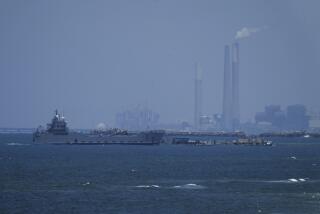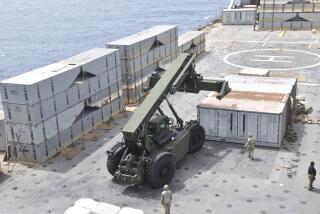U.S. Sets Up Sea Barricade to Halt Haiti Refugees
- Share via
MIAMI — The United States ordered an unprecedented naval barricade Friday around Haiti to block a feared exodus of refugees, saying it was necessary to prevent a “massive loss of life at sea.”
Twenty-two U.S. Coast Guard and Navy ships, along with a dozen aircraft, will ring the Haitian coast outside its 12-mile territorial limit and patrol the 600-mile escape route to Florida, said Adm. J. William Kime.
The Coast Guard commandant said he launched Operation Able Manner after consulting both the Bush and incoming Clinton administrations.
“We hope our efforts . . . will greatly deter the numbers who will venture out in what is inherently a very unsafe effort,” Kime said.
Coast Guard intelligence has spotted 200 boats under construction in Haiti, and more than 1,400 already in the water could be used in a massive boatlift, Kime said.
About 900 Haitians already have been stopped this year, and Kime said a worst-case scenario would send 100,000 to 200,000 refugees toward Florida.
But recent broadcasts by ousted Haitian President Jean-Bertrand Aristide and President-elect Clinton asking Haitians to stay home and help democratize the country should keep many potential immigrants at home, he said.
The U.S. ships will stop rickety, overcrowded sailboats and small freighters that have sailed thousands of Haitians to Florida--or sometimes to their deaths, he said, citing the recent reported sinking of a freighter off Cuba with 400 people aboard. Normal shipping will be allowed through.
“This is not a blockade,” Kime said. “The concern we have is for the potential massive loss of life at sea.”
The commander repeatedly refused to call the mission a blockade, a term with hostile overtones when used to describe actions aimed at stopping shipments of goods or weapons during wartime.
Haitian refugee advocates in Miami were quick to condemn the plan, saying 3,000 of those forcibly returned so far have been executed by the military government. They noted no immigration officials will be on the U.S. boats to consider political asylum claims.
“They cannot put up a blockade at sea and say they are concerned for the lives of the people when they are not giving safety and security inside the country,” said Rolande Dorancy, head of the Haitian Refugee Center in Miami.
Dorancy said if the United States is serious about saving lives, it also should intercept Cuban rafters who cross the Florida Straits.
“Why a blockade for Haiti and none for Cuba?” she asked.
Clinton had promised during his election campaign to reverse a Bush Administration policy of forcibly returning Haitians who try to flee by sea to the United States. But on Thursday, six days before he takes office, Clinton said in his first foreign policy initiative he would temporarily continue the policy to avoid a “humanitarian tragedy.”
Attorney Ira Kurzban, who coincidentally filed a federal lawsuit Friday in Miami aimed at protecting the rights of refugees who reach the United States, criticized Clinton for breaking the campaign promise.
“I agree with candidate Clinton that the use of the Coast Guard to send people back without any kind of hearing is morally outrageous--I don’t know what has changed,” he said.
Kime said although there are some risks, Able Manner should ultimately save lives. He pointed out the Coast Guard’s record since the interception effort began in 1981.
“We have safely interdicted and rescued at sea over 40,000 Haitians--men, women and children--without the loss of a single life,” the admiral said.
Able Manner, which will include planes and helicopters from the U.S. Navy base at Guantanamo, Cuba, will enlist about 12 heavy and medium Coast Guard cutters, five patrol boats and five Navy ships, Kime said.
The 378-foot cutter Gallatin from New York will be the command ship.
Kime conceded the effort will cut into the Coast Guard’s usual tasks. Where only one cutter is usually patrolling off Haiti, the operation will now require 12 of the service’s 30 heavy and medium cutters on the East Coast.
More to Read
Sign up for Essential California
The most important California stories and recommendations in your inbox every morning.
You may occasionally receive promotional content from the Los Angeles Times.













